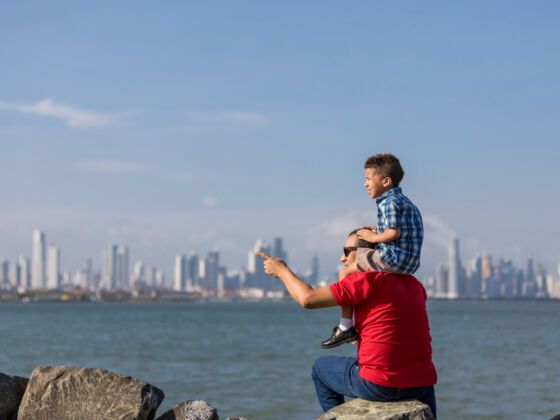On the offshoots of Via Argentina you’ll find open-air pubs, live classical guitar courtyard cafes, and a nice lineup of boutique shops — all typical for a city, yes, except they’re exceptionally lively here. Backed by the game-changing $5.25 billion expansion of the Panama Canal, most economists agree the growth is more than sufficiently supported.
Abundance shows itself in many forms, though, and perhaps more appealing to the indie traveler is the abundance of places to experience. Beyond the cosmopolitan lights along the Bahia de Panama are microclimates and distinct cultures, ranging from remote tracts of uninhibited jungle in the Darien to checkerboard agriculture hillsides in the highlands. Infrastructure is also abundant here, in a big way. You’ll probably feel more apt to hit the road on a whim than you would in other countries in the region…and you should.
Chiriqui
Blend all the best elements of Central America into one quiet little region, then add the Parque Internacional de La Amistad — that’s the draw. The local Chiricanos themselves are enough of a reason to come. For the friendly visitor passing through, there always seems to be an open room and a warm meal.
Boquete is the flagship of the region, and has received its fair share of press (and growth) in recent years. The bajareque is a thin mist that falls regularly from clouds smattering the top of Volcan Baru and other mountains that rim the valley. If you’re lucky enough to run into Olga at some punto de encuentro, she’ll most likely be able to point out the first quintuple rainbow you’ve ever seen.
While the traditional warmup is the Sendero de Los Quetzales, the hiking possibilities in this region are mind blowing. And if you surf, well then, you have to figure it out for yourself — a map and a boat and a south swell will suffice.
Bio- (cultural-) diversity
Through nothing more than its geographic position, Panama has extraordinary ecological and cultural diversity. It is the land bridge the fuses the people, wildlife, and flora of two massive, inherently distinct continents, and you feel it from the moment you hit the ground. On a city street corner you’ll find the juxtaposition of indigenous people like the Embera with psuedo-European Venezuelan corporate transplants.
The resplendent male quetzal sits just outside a private finca housing over 2,600 species of orchids. A freewheeling surfer paddles over a sperm whale off the coast of Isla Coiba. What does this bring to the table aside from the obvious? A penchant to expand your comfort zone. There are few places in the world where you’ll encounter or have to deal with so many walks of life, and the gift is their proximity.
The currency
Panama uses the US dollar, which can be convenient in a variety of ways, and for a variety of currency holders. For those from the United States it spells easy travel, and refreshingly straightforward purchases — something to appreciate considering the relatively modest prices around the country. It is admittedly appealing to pay for an appetizer or beer with a few silver quarters.
But more intriguing than the widely accepted form of currency is the one accepted until only recently in the politically autonomous Comarca de Kuna Yala — the coconut, and everything it represents. With impressive tenacity, the indigenous Kuna have managed to independently run their narrow slice of Caribbean life in the face of modern socioeconomic pressures. The result is a rare place on Earth where traditional forms of living are still paramount.
The Darien Gap
The Darien is known to most as the “Gap” that separates the Americas. Before the 1990s there wasn’t a single road in the entire province. The flora, fauna, and human inhabitants had been allowed to exist in a union unchanged for centuries. But the impenetrable reputation is fading; newly paved roads and capitalism at its environmental worst are encroaching on the northern edges, where primary forest is being thinned.
Plain and simple, this is not the forest next door, and it should not be seen as such. All preservation ideas aside (and guerilla warfare for that matter), the chance to experience some of the most unspoiled ecological terrain on this planet is still there. If you don’t think you can muster it, read the story of Pat Farmer, an ultra-marathon runner who ran from the North Pole to the South Pole last year, traversing the Darien Gap in four days with the assistance of 17 armed soldiers.
Five UNESCO World Heritage Sites
Panama is home to more UNESCO sites than any other country in the region. The World Heritage Center describes them all. What’s most interesting is that a travel itinerary based on each of these sites would highlight every other reason to go to Panama listed above. It’s a solid start.
* * *
6 tips if you go
- In Panama City, explore the area around the canal on kayaks and mountain bikes and look for howler and white-faced capuchin monkeys — just 20 minutes outside the city center.
- Tour the Panama Canal at Miraflores Locks — sounds boring but the history is fascinating.
- Meet the gente indigeno — the indigenous Embera tribe has accessible villages in gorgeous rainforest just an hour outside of Panama City.
- For a luxury kick, stay at the Westin Playa Bonita in Panama City, the only hotel with a real beach.
- High above the valley of Boquete in an area known as Alto Jaramillo is a farm growing the best coffee in the world.
- Get to the islands. There are 3 main chains: San Blas, Bocas del Toro, and the Pearl Islands. In addition, Isla Coiba and the islands off the Golfo de Chiriqui are recommended to explore.
